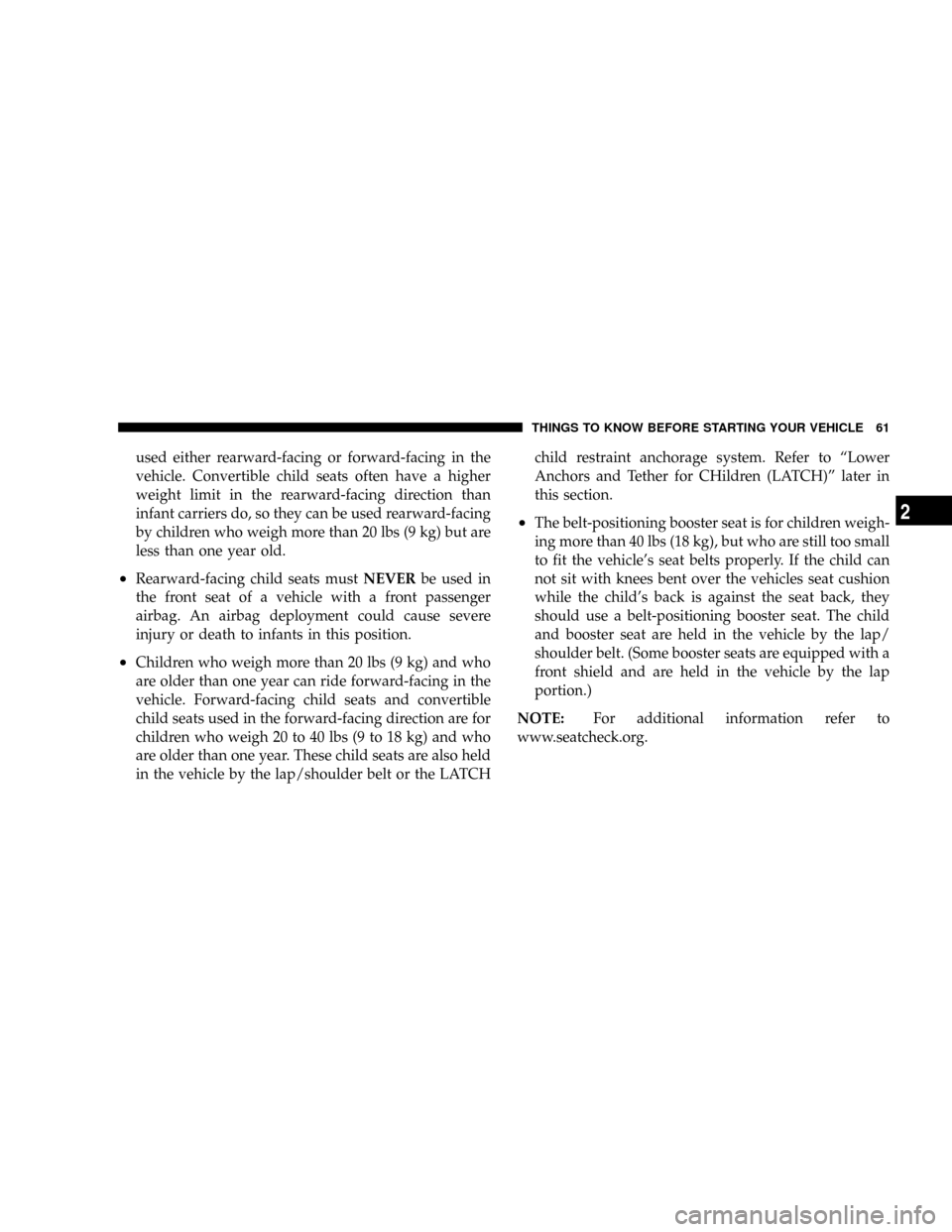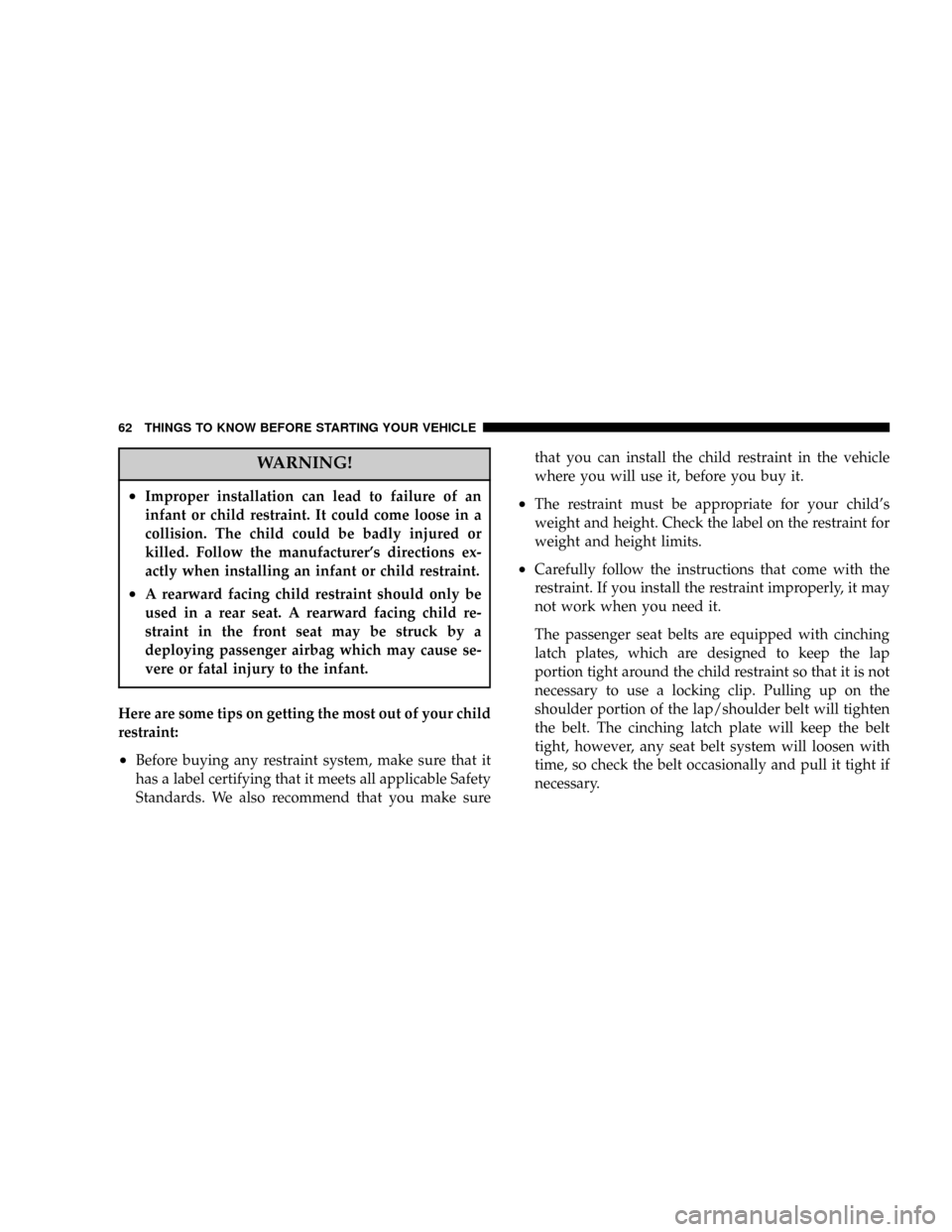Page 61 of 401

used either rearward-facing or forward-facing in the
vehicle. Convertible child seats often have a higher
weight limit in the rearward-facing direction than
infant carriers do, so they can be used rearward-facing
by children who weigh more than 20 lbs (9 kg) but are
less than one year old.
²Rearward-facing child seats mustNEVERbe used in
the front seat of a vehicle with a front passenger
airbag. An airbag deployment could cause severe
injury or death to infants in this position.
²Children who weigh more than 20 lbs (9 kg) and who
are older than one year can ride forward-facing in the
vehicle. Forward-facing child seats and convertible
child seats used in the forward-facing direction are for
children who weigh 20 to 40 lbs (9 to 18 kg) and who
are older than one year. These child seats are also held
in the vehicle by the lap/shoulder belt or the LATCHchild restraint anchorage system. Refer to ªLower
Anchors and Tether for CHildren (LATCH)º later in
this section.
²The belt-positioning booster seat is for children weigh-
ing more than 40 lbs (18 kg), but who are still too small
to fit the vehicle's seat belts properly. If the child can
not sit with knees bent over the vehicles seat cushion
while the child's back is against the seat back, they
should use a belt-positioning booster seat. The child
and booster seat are held in the vehicle by the lap/
shoulder belt. (Some booster seats are equipped with a
front shield and are held in the vehicle by the lap
portion.)
NOTE:For additional information refer to
www.seatcheck.org.
THINGS TO KNOW BEFORE STARTING YOUR VEHICLE 61
2
Page 62 of 401

WARNING!
²Improper installation can lead to failure of an
infant or child restraint. It could come loose in a
collision. The child could be badly injured or
killed. Follow the manufacturer's directions ex-
actly when installing an infant or child restraint.
²A rearward facing child restraint should only be
used in a rear seat. A rearward facing child re-
straint in the front seat may be struck by a
deploying passenger airbag which may cause se-
vere or fatal injury to the infant.
Here are some tips on getting the most out of your child
restraint:
²Before buying any restraint system, make sure that it
has a label certifying that it meets all applicable Safety
Standards. We also recommend that you make surethat you can install the child restraint in the vehicle
where you will use it, before you buy it.
²The restraint must be appropriate for your child's
weight and height. Check the label on the restraint for
weight and height limits.
²Carefully follow the instructions that come with the
restraint. If you install the restraint improperly, it may
not work when you need it.
The passenger seat belts are equipped with cinching
latch plates, which are designed to keep the lap
portion tight around the child restraint so that it is not
necessary to use a locking clip. Pulling up on the
shoulder portion of the lap/shoulder belt will tighten
the belt. The cinching latch plate will keep the belt
tight, however, any seat belt system will loosen with
time, so check the belt occasionally and pull it tight if
necessary.
62 THINGS TO KNOW BEFORE STARTING YOUR VEHICLE
Page 68 of 401

²Check belt fit periodically. A child's squirming or
slouching can move the belt out of position.
²If the shoulder belt contacts the face or neck, move the
child closer to the center of the vehicle. If this doesn't
help, move the child to the center rear seating position
and use the lap belt. Never allow a child to put the
shoulder belt under an arm or behind their back.
Transporting Pets
Airbags deploying in the front seat could harm your pet.
An unrestrained pet could be thrown about and possibly
injured, or injure a passenger during panic braking or in
a collision.
Pets should be restrained in the rear seat in pet harnesses
or pet carriers that are secured by seat belts.
REAR SEAT DELETE FEATURE (COMMERCIAL
VEHICLES ONLY) Ð IF EQUIPPED
Commercial cargo vehicles are not designed for use as a
family vehicle and are not intended for carrying children
in the front passenger seat. However, if you must carry a
child in a vehicle without a rear seat, the passenger seat
should be moved to the full rearward position and the
child must be in a proper restraint system based on it's
age, size and weight. NEVER carry a child in a rear facing
infant carrier in a vehicle without rear seats. In an
accident, serious injury or death may occur from the
deploying passenger air bag.
This vehicle is equipped with a child restraint tether
anchor located on the floor, behind the front passenger
seat.Use this tether anchor to secure only forward
facing child restraints equipped with an upper tether
strap.
68 THINGS TO KNOW BEFORE STARTING YOUR VEHICLE
Page 96 of 401
Plastic Grocery Bag Retainer
Retainer hooks which will hold plastic grocery bag
handles are built into the seatbacks of all rear seats and
some front seats. The floor supports the partial weight of
the bagged goods.
Rear-Most Bench Seat
The seat position can be adjusted fore and aft to any of
three positions - normal (rearward), intermediate, and
full forward. In this way varying needs for legroom and
cargo space behind the seat can be accommodated.
The release lever is below the seat and is accessible from
the front and back of the seat.
96 UNDERSTANDING THE FEATURES OF YOUR VEHICLE
Page 149 of 401
Cargo Organizer removal
Unscrew the two plastic fasteners located on the floor of
the rear of the cargo area and remove the cargo organizer
from the vehicle.
NOTE:The cargo organizer must be removed to take
out the third row seat.
ROOF LUGGAGE RACK Ð IF EQUIPPED
The crossbars and siderails are designed to carry the
weight on vehicles equipped with a luggage rack. The
load must not exceed 150 lbs (68 kg), and should be
uniformly distributed over the luggage rack crossbars.
Distribute cargo weight evenly on the roof rack crossbars.
The roof rack does not increase the total load carrying
UNDERSTANDING THE FEATURES OF YOUR VEHICLE 149
3
Page 237 of 401
mTire Rotation Recommendations............273
mFuel Requirements......................274
NReformulated Gasoline.................275
NGasoline/Oxygenate Blends..............275
NMMT In Gasoline.....................276
NSulfur In Gasoline.....................277
NMaterials Added To Fuel................277
NFuel System Cautions..................278
NCarbon Monoxide Warnings..............278
mAdding Fuel..........................279NFuel Filler Cap (Gas Cap)...............279
mVehicle Loading........................281
NVehicle Certification Label...............281
NGross Vehicle Weight Rating (GVWR).......282
NGross Axle Weight Rating (GAWR).........282
NOverloading.........................282
NLoading............................283
mTrailer Towing.........................284
NWarranty Requirements.................284
STARTING AND OPERATING 237
5
Page 256 of 401
Tire Loading and Tire Pressure
Tire Placard Location
NOTE:Some vehicles have a ªTire and Loading Infor-
mationº placard located on the driver's side ªBº pillar.
Tire and Loading Information Placard
This placard tells you important information about the,
1) number of people that can be carried in the vehicle
2) the total weight your vehicle can carry
3) the tire size designed for your vehicle
4) the cold tire inflation pressures for the front, rear
and spare tires.
256 STARTING AND OPERATING
Page 257 of 401

Loading
The vehicle maximum load on the tire must not exceed
the load carrying capacity of the tire on your vehicle. You
will not exceed the tire's load carrying capacity if you
adhere to the loading conditions, tire size and cold tire
inflation pressures specified on the Tire and Loading
Information placard and the Vehicle Loading section of
this manual.
NOTE:Under a maximum loaded vehicle condition,
gross axle weight ratings (GAWR's) for the front and rear
axles must not be exceeded. For further information on
GAWR's, vehicle loading and trailer towing, see the
Vehicle Loading section of this manual.
To determine the maximum loading conditions of your
vehicle, locate the statement ªThe combined weight of
occupants and cargo should never exceed XXX kg or XXX
lbs.º on the Tire and Loading Information placard. Thecombined weight of occupants, cargo/luggage and
trailer tongue weight (if applicable) should never exceed
the weight referenced here.
Steps for Determining Correct Load Limit
1. Locate the statement ªThe combined weight of occu-
pants and cargo should never exceed XXX poundsº on
your vehicle's placard.
2. Determine the combined weight of the driver and
passengers that will be riding in your vehicle.
3. Subtract the combined weight of the driver and pas-
sengers from XXX kilograms or XXX pounds.
4. The resulting figure equals the available amount of
cargo and luggage load capacity. For example, if ªXXXº
amount equals 1400 lbs. and there will be five 150 lb.
passengers in your vehicle, the amount of available cargo
and luggage load capacity is 650 lb. (1400±750 (5 x 150) =
650 lb.)
STARTING AND OPERATING 257
5